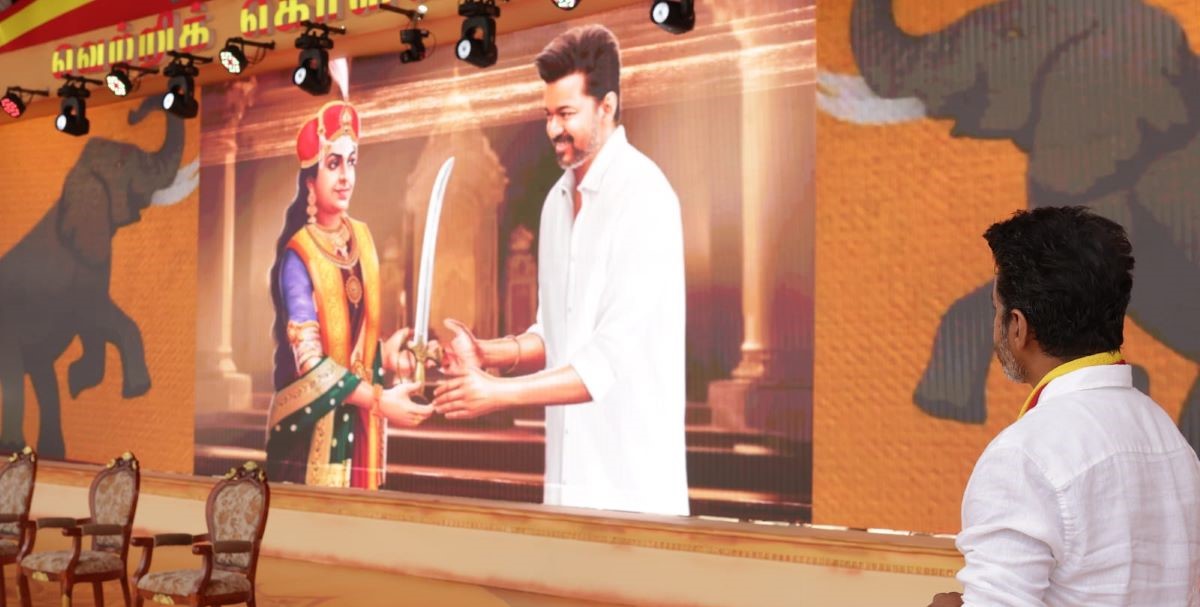Vijay presented his party's ideology, which was actually developed by the DMK from 1949 to 1957. Each sentence of his speech echoed the DMK's distinction from Dravidar Kazhagam regarding the critical issue of faith
Published Nov 02, 2024 | 12:38 PM ⚊ Updated Nov 02, 2024 | 12:38 PM

Much Ado about nothing: Actor Vijay's political entry(Supplied)
A report in the Hindu read “Vijay cannot be ignored” and asserted that his speech had drawn admiration and criticism in equal measure. Actor Vijay, aged 50, launched a regional political party, Tamilaga Vettri Kazhagam (TVK) in a rally in Vikravandi town of the Villupuram district last week, that generated a substantial political buzz about the changing face of Tamil politics.
While the fate of political parties are determined in the elections, the tone and tenor of the political address at hustings inform the possible trajectory of any fledgling political party.
There was a conscious attempt only to project Vijay and there was no other political invitees at a rally that had consumed huge investment both in terms of money and human resources. It was clearly packaged to present one person to be a messiah of change. With hero-worship as the central tenant, it is impossible to fight the idea of fascism. He makes light of the threat of extreme centralisation we witness today and lazily equates the BJP with the DMK.
In a flowing Tamil speech, he said: “They (The DMK) go on about ‘fascism, fascism, fascism’ and what are they [DMK]? Payasam?”. He seems to have missed the crucial difference between the two contesting political ideologies—while the DMK strives to realise the ideals of “nation as coming together”, the BJP represents the idea of “nation as holding together.”
What he presented as his party’s ideology was the one developed by the DMK between 1949 and 1957. In fact, every sentence of his speech can be traced back to the way the DMK differentiated itself from its parent organisation Dravidar Kazhagam on the crucial issue of faith.
Let us examine two of his assertions. First, Vijay declared: “I embrace the ideology of Periyar sans his atheism.” This has been the core of Annadurai’s political praxis. Annadurai invoked eighth century mystic Thirumoolar’s observation and made it the creed of his party: “Ondra Kulam, oruvana Devan” (Humanity is one clan, and we all have one God). This idea was taken to the wider public by Karunanidhi in his brilliant script for the film Parasakthi in 1952. Earlier in a seminar, I recorded the central democratic role played by the film Parasakthi in transforming the Dravida Munnetra Kazhagam from being a political idea to a political reality.
The film, in a sense, documents the shift from Periayarist maximalist positions to Annadurai’s realistic fallback positions. As academic Pandian pointed out in his 1991 EPW essay, while ‘Parasakthi did attack religion in definitive terms, it also at once exhibited certain ambivalence about religion. This ambivalence comes out candidly in Gunasekaran’s vituperative monologue in the court—almost at the close of the film.’ The lengthy monologue: ‘I created trouble in the temple; not because there should not be temples, but because temples should not become the den of dangerous men. [I] attacked the ‘poojari’. Not because he is a devotee, but because devotion has become a daytime disguise.
It is important to keep the narratives that captured the popular imagination in mind while evaluating any new comers to the political arena. For instance, as I have written elsewhere, we need to remember is the distinction between the DK and the DMK on their respective positions towards faith: while the DK rejected religion in toto, the DMK rejected religious obscurantism.
In 1953, a year after the release of Parasakthi, Periyar led a protest by breaking the idols of Pillayar. Anna’s response was akin to the dialogues of Parasakthi. He said: “I would neither break a Pillayar statue or a coconut (referring to the religious offering)”. This fine distinction is the one that propelled Karunanidhi as the Chief Minister to nominate the reformist pontiff Kundrakukudi Adigalaar to the legislative council, to introduce Tamil archanai and to legislate a law that permitted priesthood for all, regardless of caste. The challenges the government had to face is one example of the political wrestling between a reformist political imagination and a status quoist judiciary.
Second important element in Vijay’s speech was that the TVK is ready for a coalition government if he wins the Assembly elections, in order to tap into the growing demands in a section of the alliance partners of the DMK such as VCK and a section of the Congress that feels that it has been out of power for nearly six decades. This observation negates the political will of the state.
The state has always voted for a single leadership with giving little room for external manipulation of people’s will. Every election since 1957, when the present boundary of state was defined after the linguistic reorganisation, the people of Tamil Nadu have supported stability and never supported flux. In 1957 and 1962, they voted for the Congress; in 1967 and 1971 they voted for the DMK; in 1977, 1980 and 1984 they voted for the AIADMK; 1989 for the DMK; 1991 for the AIADMK; 1996 for the DMK; 2001 for the AIADMK; 2006 for the DMK; 2011 and 2016 for the AIADMK and the 2021 for the DMK.
The only time when there was an explicit power sharing arrangement, it failed the alliance fully. It was in 1980 when the DMK and the Congress entered a 50:50 seat sharing formula, people of the state voted against the alliance. The popular will of the people in the state is: self-rule in the state and the collective- rule at the Union. Vijay’s idea of coalition government at the state may not get the endorsement of the people.
A S Panneerselvan is a fellow at Roja Muthiah Research Library, Chennai
(Edited by Ananya Rao)
